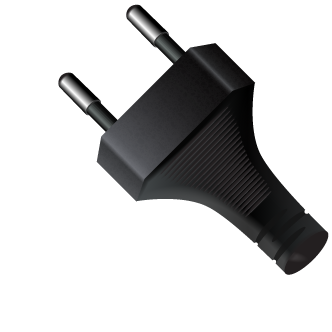Overseas travel offers a lot of opportunities to meet new people, try new food, and learn more about some other part of the world than you can in books and websites, whether you choose to travel for vacation, to visit family, work on a social program, or are sent by your employer to accomplish work.
Whatever our reasons, though, we seldom want to leave every vestige of our home lives at home when we travel. For most of us, this means travelling with electronics and/or electrical gear which can be challenging. And if you’re relocating and have plans to use your household items at the destination, the challenge could be double.
Depending on your travel destination meeting this challenge could be as simple as adapting the physical connectors on your existing gear to as complex as running a whole house frequency converter. You see, due to the history of electrification in the world a lot of use use vastly different and often incompatible power supply systems.
Power Delivery Basics
In general (but with exceptions) the world is divided into two camps for domestic power: regions that use 100 VAC (volts alternating current) to 120 VAC at 60 Hz, and those that use 220 VAC to 240 VAC at 50 Hz. The range in voltages isn’t a supply tolerance; different suppliers simply supply a voltage somewhere in this range, and most equipment designed for a voltage range does have an operating tolerance that accommodates this range.
Some countries, such as Japan, have both systems in use in different parts of the country.
While the emphasis of this article is on domestic power, it’s still worth it to note that industrial and commercial power are usually supplied at substantially higher voltages than the domestic supply, although the supply frequency is generally the same. In some regions, commercial customers are responsible for stepping down the industrial supply into useful, domestic power on their own.
My fellow engineers and the pedantic among you may be grating teeth at my every use of the word “power.” Yes, if I was among fellow engineers I would use “energy” in every instance above, and if I was among grammarians I would use “if I were among…” (oh, whom am I kidding? “If I was…” sounds horrible!). In many cases it’s critical to make the distinction, but in casual speech we shouldn’t worry about work versus work over time.
Voltage, Current, Frequency, and Sockets
Voltage
Voltage is often referred to as electromotive force (maybe not so often in your house). On its own it’s just a potential, like the water behind your closed faucet. It has to flow somewhere to do work. If there's too much force, though, it’s likely to burst out of its container which will make you quite sad, as this condition is often characterized by smoke, melting gear, and maybe even fire.
A lot of non-English languages use their form of “open” or “close” to refer to turning a device “on” or “off.” Like the valve in a faucet, a switch is also opened or closed. This used to be more common in English, too. Pay closer attention to your great grandfather next time you have a visit; you may hear him mention opening the lights.
Things aren’t necessarily better when travelling the other direction, either. While most items designed for 220 VAC won't melt into a pile of plastic when plugged into 110 VAC sources, it’s certain that you will be disappointed if the design doesn’t support 110 VAC. Consider, for example, a combination of Ohm’s Law and the Power Law:
Given a 100Ω resistive load, your item expects to be able to draw 484 watts to work properly at 220 VAC, but can only draw 121 watts to work at 110 VAC. Half the voltage results in only one-quarter of the power! If you reconsider the first description, you should suddenly realize why it’s so easy to let the smoke out of your device in an over-voltage situation.
Squares and inverse squares as demonstrated in the example above are plentiful in nature. Perhaps you don’t consider your highly-engineer device a part of nature, but the electricity that makes it work is certainly natural.
The example shows the simplest case: a pure resistive load, and doesn’t consider inductive loads (or capacitive loads, for that matter). Think of a resistive load as being similar to a light bulb where only light and heat are produced. Inductive loads are usually the result of something that produces motion such as common motors like those found in hair dryers.
Supply voltage is the most critical factor when trying to use your electrical equipment in other lands.
Current
You might notice that we cleverly combined Ohm’s Law and the Power Law about in order to delay any discussion of current until now. Current, which is measure in amperes (or amps, or A), can be regarded as the volume of the power at a single point at any instantaneous moment in time. Of course power is also the volume of power at any instantaneous moment in time. And of course energy is the expression of that volume per period of time (instantaneous, you might remember, is a volume of time that approaches zero infinitesimally).
No doubt you’ve spotted some logical inconsistencies with those definitions, including the use of a definition to define itself. Now you know why engineers tend to be pedantic in our use of technical terms rather than use personal definitions that were made up for a blog article. For our purposes, though, these blog definitions are good enough; current is something that we have to pay attention to, and it’s something that specific to your device and not necessarily related to your destination’s power delivery infrastructure (unless, of course, your device is an industrial control intended to make resistance spot welds on sheet aluminum).
Just for fun, let’s look at the power requirements for spot welding aluminum. We may need approximately 30 kA of current at 9 VDC for 500 ms. The power law tells us that this is 270,000 watts! If we make 9,000 spot welds at 500 ms each, that is 270 kilowatt-hours of energy use. At the residential rate of 14.23¢ per kW/h in my home state of Michigan, USA, I suppose it would cost me approximately USD $38 in energy to weld two aluminum Jaguar car bodies together.
Frequency
Hertz is the frequency of change of direction of the flow of energy in AC power, or even more generally the frequency of vector changes in any AC-like signal. If you measure standard AC voltage in much of the world, you will see that at 50 Hz, the voltage is exactly zero volts 100 times every second (and you may see that the 240 volts actually peaks at an amplitude of 380 volts 100 times per second).
Depending on your geekiness level, you can use complicated calculus, or fairly simple trigonometry, or dead simple arithmetic to calculate the area of the AC curves and arrive at the nominal 240 VAC.
Like iPhones and clean drinking water, we tend to take AC motors for granted; they’re ubiquitous, after all. However there’s a lot of engineering that goes into them, the least of which has to do with ball-bearings versus needle bearings. The fact is, though, there are a lot of design considerations and they are generally tailored to run at a specific frequency for a specific load (load meaning the work to be performed).
When AC motors run at a lower frequency that they’re designed for, they operate slowly and have a tendency to overheat which can lead to motor failure. A handheld hair dryer has a small load compared to a refrigerator compressor, and so the effect on a hair dryer may be negligible. Single phase motors (the kind we would have as personal possessions) also have a lower starting torque, meaning they may not even be able to start at all! Finally, single phase motors require some type of starting coil to ensure they start rotating in the correct direction, and these can fail very rapidly if they’re not turned off as soon as the motor is running at speed. Such motors may use centrifugal switches to turn off the starter coil, and if the switch isn’t sensitive enough at 83% of the motor speed (that is, 50/60th of the design speed), this coil can burn out in short order leaving you with an inoperable motor.
If you read this far only to learn whether or not you can recharge your Canadian iPhone in mainland China, then the answer is yes, you can, with no special equipment. But for many others, you sometimes have to consider power supply frequency when planning to use your electrical goods overseas.
Sockets
Finally, despite the fairly good alignment between the two large camps, you will find that one of the most frustrating experiences when travelling is finding a socket to match your plug. It seems that every country wants to find a better way of doing things, and so a vast proliferation of socket types means that even travellers from, say, Germany to Italy have to fret over how they will charge their phones (although they only have to fret until completion of their research).
Unfortunately any time anyone tries to implement a new standard, this (xkcd) tends to happen.
So What Do I Do About It?
Give the knowledge above, the first step (after deciding where you’re travelling to) is to determine the differences between your home country power supply and the destination region power supply. Don’t be satisfied with assumptions. Although Canada is a strange, foreign, hostile, cold land to many Merkins, the power supply and domestic sockets are identical. You can stop flooding Yahoo! Answers with questions about charging your Samsung Galaxy there. On the opposite extreme, although Hong Kong was returned to Chinese rule in 1997, travellers between the two will have to be sure to bring some type of adapter.
As it is with so many things, Wikipedia can be a good resource to determine the voltage, frequency, and socket type used in various countries and regions. As always with Wikipedia, use it as a reference only and try to find another source of verification!
Having established your knowledge of the differences, now is the time to learn to understand your devices’ power supply requirements.
Look at and understand the data label
Every electrical device in all developed regions of the world require a data label or data plate attached to them and to any detachable power supply blocks/bricks/transformers. Here is an example borrowed from Apple’s website:
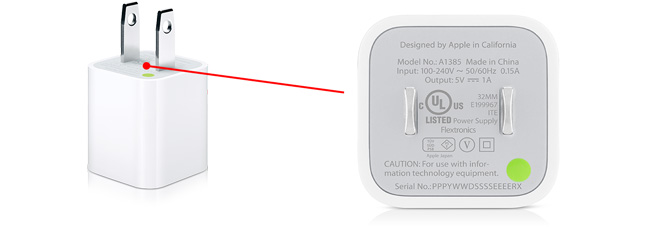
The pertinent information on this label is the value set for “input.” Let’s examine these data:
- 100-240V
- This device can be powered by any voltage from 100 VAC to 240 VAC.
- 50/60Hz
- It works at both 50 Hz and 60 Hz.
- 0.15A
- It will draw 0.15 A of current.
This last point is interesting. Although we don’t require any knowledge of the output power, this adapter indirectly indicates that it’s a 5 W charger, i.e., 1 A at 5 VDC. If the load is 5 watts, shouldn’t the current draw reflect that? At 240 VAC, a 0.15 amp draw would indicate a power consumption of 36 watts! At the low operating voltage of 100 VAC, though, we’re still drawing 9 watts of power from the mains to provide 5 watts of power to your device. Assuming a 74% efficiency for an Apple power supply, and given that this is a switching power supply rather than a dumb transformer, then a 0.15 amp draw for a 100 VAC source seems fairly reasonable.
Although you could calculate the current draw for higher supply voltages for each of your devices, it’s probably a good idea simply to use the stated current on the manufacturers’ labels.
Armed with the knowledge about, it’s fairly evident that we can use this charger pretty much anywhere in the world, as long as we can fit the connector’s pins into a socket, meaning that you would only have to acquire a suitable pin or outlet adapter.
But what if we have device such as this?
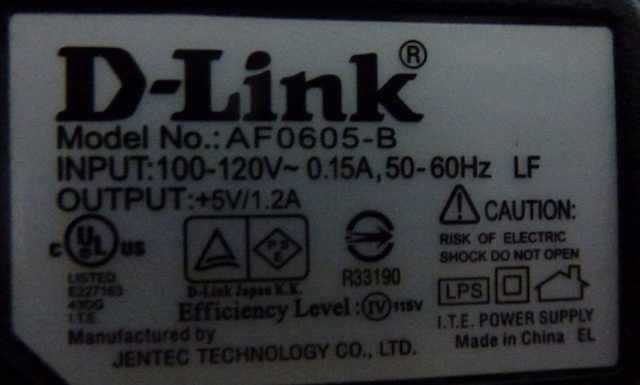
Aside from the fact that I’d be upset that DLink didn’t provide a power supply that obviously has such low power requirements that’s not universal voltage, we can see that the input amperes and the output watts are fairly similar to the Apple power supply, above. And importantly the line frequency doesn’t appear to be an issue. If you were to travel to a 220 VAC region, you would want to be sure to being along a power converter (which typically also includes the connector adapter).
Let’s have a look at another representative data label:

Perhaps you won’t travel with your stand mixer during a two week vacation to Belgium, but if you accept an expat assignment on behalf of your company to Belgium for three years, you will most likely want to bring your pricey household goods with you.
Aside from the strict requirement for 120 VAC and 60 Hz (with no operating ranges specified), the power requirement is given as 575 watts instead of a value in amps. This is actually pretty convenient because it lets us calculate the power requirement if, say, our town used 110 VAC power instead of 120 VAC. It further conveniences us because typical power converters and transformers are rated in watts instead of amps. In any case at 120 VAC, 575 W reflects an approximate draw of 4.8 amperes. And although not stated on the data label, I hope you recognize that this device most certainly includes some type of single phase AC motor. If you want to use this appliance in Belgium, then in addition to a pin or socket adaptor, you will have to find a transformer with sufficient wattage capacity, as it’s very unlikely that you will encounter a typical traveller power converter capable of handling 575 W.
One last example before we move on to a discussion of adapter types: Although I was unable to obtain a photograph of the data plate, I present this picture of an AN/TPN-18A, which is a ground controlled approach air traffic control radar that was in use by the United States Army for a period of time.
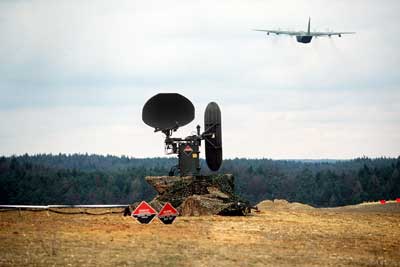
Amazingly this giant, industrial machine uses 110 VAC power! But upon closer examination we can readily see that it requires 400 Hz and something called 3-phase 120/208 V. When the Army travels with these, they typically bring along their own 15 KW, 3-phase, 400 Hz generator. A do-it-yourself solution will remain safely outside the scope of this article.
What to Take Along
By now, you will have determined some basic needs that need satisfying if you want to successfully use your electrical and electronic equipment overseas. You may not know exactly what you need to purchase, however. Let’s have a look at some options.
- Outlet (or pin) adapters (sometimes simply called adapters)
- Outlet adapters are the simplest and (unless purchased in desperation at the last minute in an airport shop) the cheapest of devices. They simply allow you to plug your plug into them, and the adapter can plug into the socket of your destination region. No type of power conversion is performed, and so you should only use these types of adapters if your device is compatible with the power supply system at your destination.
- Power Converter (or Power Adapter)
- These devices almost always include the plug pin compatibility features of socket adapters, but also convert (not transform!) the electricity from one form to another, such as stepping up the voltage from 110 VAC to 220 VAC, or stepping down the voltage from 240 VAC to 120 VAC.
- Beware of these devices! They are not true transformers and should only ever be used with resistive loads. While there are some very high end models that use inverters to output a proper AC signal at the desired voltage, the vast majority of step-down models use a simple device called an SCR or thyristor that simply splits each half-cycle in half. You can look up all of those words in order to understand the meaning, or you can be satisfied by knowing that this can causes transformer loads to saturate and overheat, and cause motor loads to fail completely (given that motors are transformers).
- For many things, though, their extremely light weight and low costs presents no problems.
- Consider also the current requirements, as discussed above. Make sure your device does not draw more current and/or power than the converter is capable of providing.
- Transformers
- If you require motor loads, transformer loads, or simply have a lot of things to plug in such that you exceed the capacity of a power converter, then you probably would be much happier with a transformer. Unlike a converter as described above, a transformer replicates the source AC waveform with nearly perfect accuracy (if you understand how a transformer works then you will understand why).
- Low frequency transformers (which these are) tend to have a lot of copper and require a fairly heavy iron core when significant currents are involved. This detracts substantially from their appeal to a typical traveller, as all of this copper and iron make them quite heavy. But if you insist on powering a stand mixer or plasma television screen, there will certainly be no substitute for a transformer.
- Smaller, true transformers are available, too. While still heavy for their size, the portability they offer may still be attractive if there’s a certain transformer or motor load that you can’t make do without during your travels.
Wrap Up
I currently live in China as a foreigner, and luckily nearly everything I own works on dual voltages (the kitchen equipment is the largest exception). One thing that I find indispensable while in China and on business trips in the region is a multi outlet strip similar to this one:
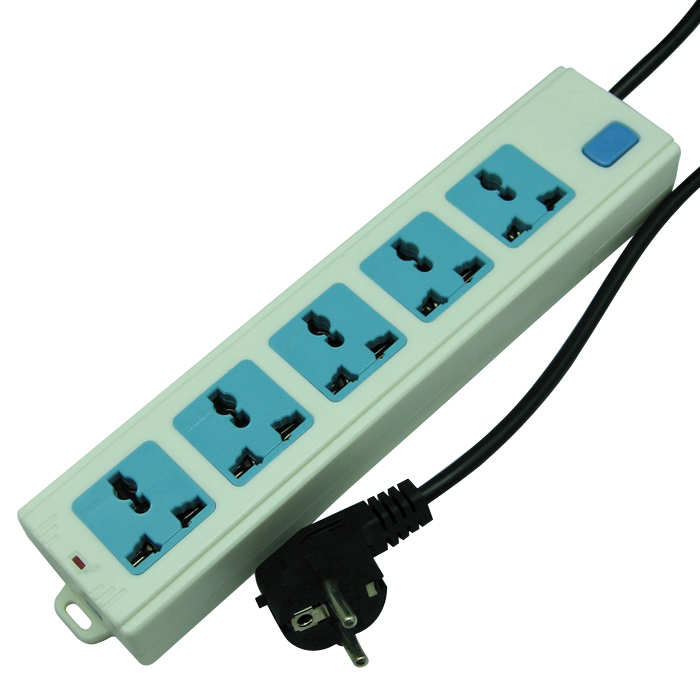
So far is has allowed me to plug in any device from any country that I’ve travelled to with the exception of South Africa, which uses Godzilla-sized plugs for even the smallest of loads.
Your needs will likely be different. I hope this article has been more entertaining than informative, but informative nonetheless.
Cheers.
